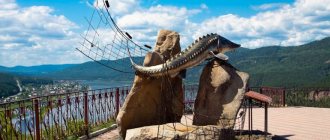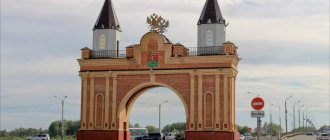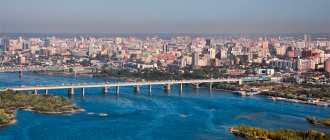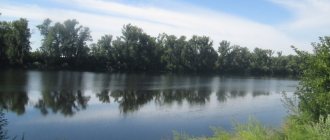The Krasnoyarsk region is located in Central Siberia in the Yenisei basin. It was formed in 1934 as a result of the disaggregation of the West Siberian and East Siberian territories.
The main attraction of the Krasnoyarsk region is its beautiful natural landscapes and unique objects, which have no analogues in the world.
Biryusinsky Caves
Biryusa Caves is a whole cave complex located near the Biryusa River in the Krasnoyarsk region. It consists of 70 caves with amazingly beautiful sinter formations and complex terrain. The length of the corridors of the largest cave is 5 km, and the depth decrease is 170 m.
Most of the grottoes, passages and manholes were discovered by hunters hunting in these places, and new ones are being excavated by speleologists. Almost every cave, descent or grotto has its own name and a beautiful legend of its discovery. The most visited caves include: Divnogorskaya, Lunnaya, Kubinskaya, Geneva, Zhemchuzhnaya, Raduzhnaya, Belaya, Kristalnaya, Seven Wonders of the World, Royal Gates, etc. No less beautiful and interesting names for the descents and grottoes: Magic Labyrinth, Rings of Saturn, Squeezer, Pit of Fools, etc.
Resurrection Cathedral
The oldest stone building in Krasnoyarsk and for a long time the main cathedral of the province. Krasnoyarsk residents would probably show you its main attractions: the icon of the Transfiguration of the Lord in a solid 5.5-kilogram silver frame, a new bell tower built in 1850 with a messenger bell, and a wooden portier, painted in the time of Boris Godunov.
It would be no less interesting to visit the cemetery near the cathedral, where among the graves of the first Krasnoyarsk residents one could see the grave of Commander Rezanov, the famous traveler who died on the way from California to St. Petersburg.
The cathedral has not survived to this day. In the early 60s, the temple, which had already been converted into a mechanical plant, was demolished. The painted portico, the bell tower, and Rezanov’s grave were lost. But the icon survived - now it can be seen in the Museum of Local Lore. True, without a salary, he was handed over to the bank in 1935 for the needs of industrialization.
Great Arctic Nature Reserve
The Great Arctic Nature Reserve in the Krasnoyarsk region is located on the Taimyr Peninsula and adjacent islands of the Kara Sea. Its area is 4.1 million hectares, it is the third largest in the world and the largest nature reserve in Russia. This protected area was created in 1993 with the support of the World Wildlife Fund to protect the breeding grounds of birds that migrate along the North Atlantic route.
On the territory of the reserve, tundra permafrost is widespread, flat areas are interspersed with stone ridges of glacial origin, which largely determines the diversity of fauna and flora of these places. The main type of vegetation in the Great Arctic is lichens, which color the tundra in different colors from black to bright yellow; polar willow is also common.
The islands of the reserve are home to the smallest northern animals - lemmings, the size of the population of which determines the survival of predators - skuas, arctic foxes, woolly buzzards. In these beautiful and harsh places you can meet wild deer and polar bears.
On the territory of the Greater Arctic there is also a unique paleontological site of the Krasnoyarsk region, known as the Narwhal Cemetery - a significant place in which many bones of narwhals that died 100 thousand years ago are concentrated.
Public meeting
Another building where you would probably be taken to have fun and unwind is the Public Assembly building. At the beginning of the 20th century, this was the main party place in Krasnoyarsk. Balls were held here, a buffet was open, and gambling was played on the sly. In fact, the legislation of those years categorically prohibited gambling for money, but this did not stop Krasnoyarsk residents.
At the time of your visit, the public assembly still shared premises with the noble assembly. Both institutions could hardly fit into a small house at 67 Mira, and in 1910 the public meeting moved to a new building, known today as the “House of Officers.”
Today the house has been preserved, but no balls or meetings are held there anymore. According to 2GIS, it houses a hotel and two sports societies.
Anashensky pine forest
Anashensky Bor is a unique pine forest with a length of 18 km and an area of 5.85 hectares on the right bank of the Yenisei in the Krasnoyarsk region. This place is classified as a specially protected area as a botanical natural monument, formed in 1987 to preserve a unique forest area.
Even after many years of studying this beautiful and unusual place, experts cannot answer why it stretches from west to east precisely in the direction of the prevailing winds. Another inexplicable point is that mixed forests predominate in the region, and the forest consists of dark coniferous forest with beautiful slender and even pine trees.
Moreover, their root system is of a surface type, not an anchor type, although there are no rock formations under the ground that would impede the growth of tap roots.
Railroad bridge
In 1900, the Railway Bridge over the Yenisei was only a year old, but its main triumph was close. It was during your visit to the city on the Yenisei, several thousand kilometers to the west, in Paris, that the World Exhibition was in full swing. Its results will be summed up in November and the Krasnoyarsk Railway Bridge will be declared the winner. Exactly the same prize was awarded to the famous Eiffel Tower 11 years earlier. The gold medal in Paris remains to this day the highest achievement of Krasnoyarsk architecture.
The bridge was truly impressive. 907 meters of steel structures with spans of 144 meters, an incredible cost of 3 million royal rubles - all this aroused the sincere admiration of his contemporaries.
Alas, the bridge did not survive until 2021. In 2002, they began to dismantle it, and in 2007 it was irrevocably sold for scrap, without even leaving a piece as a souvenir.
Shushenskoye Museum-Reserve
One of the most interesting places in the Krasnoyarsk Territory is the Shushenskoye Museum-Reserve, a unique historical and architectural open-air complex with an area of 7 hectares. The basis of the museum is made up of samples and monuments of rural architecture of the late 19th - early 20th centuries. - peasant estates, a village shop, a blacksmith's shop, a tavern, a volost government building with a prison - about 195 buildings are represented on the territory of Shushenskoye.
In the houses and estates, the living conditions of the Siberians who inhabited these beautiful and picturesque places at the beginning of the last century are recreated, their main occupations and trades are shown: animal husbandry and farming, hunting and fishing, cooperage and beekeeping, felt rolling and weaving, weaving and beading, etc. etc. And in the houses where V.I. lived. Lenin during the years of Shushenskaya exile, the memorial setting is preserved.
Architecture and engineering structures
In Krasnoyarsk there are both modern and ancient architectural sights, since the city was founded in the 17th century. Most of the historical buildings are located in the center.
Particularly worth noting are the bridges of Krasnoyarsk and mini-copies of some popular European monuments.
Historical Quarter
In the center of Krasnoyarsk there are many ancient wooden houses of the 18th–19th centuries, which are the best examples of Russian architecture. They shaped the appearance of the historical quarter, which covered the space between Gorky, Marx and Dekabristov streets.
During the recent reconstruction, most of the buildings - cultural objects of local and regional significance - were restored.
In the historical quarter, the two-story wooden estate of the Belsk tradesman Grigory Nekrasov has been preserved. Built at the beginning of the 20th century, it is decorated with architectural elements from the Renaissance.
Nearby is the house of the doctor Glanz , built in 1910. This one is of interest with its white trim, bright turquoise facade and carved balusters on the spacious balcony.
Communal Bridge
There are 11 existing bridges across the Yenisei River, including Kommunalny, which was put into operation in 1961. It connects the two banks and is on the UNESCO list of sites in the “Bridge Building of the World” category.
The construction begins on Predmostnaya Square and ends on Teatralnaya Square. The communal bridge in the spirit of the Stalinist Empire or “Triumph style” was created for both cars and pedestrians.
The structure is 2300 m long and is nominally divided into two sections by a dam in the area of Rest Island. A characteristic feature of the facility is its long spans, which allow large vessels to easily navigate the river.
Church of the Transfiguration of the Lord
The Roman Catholic Church was built during the period 1909–1911. The design of the religious building is in the Gothic style: the walls are cut through with high arched windows, the roof is complemented by pointed spiers. The temple is decorated with vaults, and the dark orange, almost brown facade is decorated with bas-reliefs and sculptures.
The only 2000-pipe concert organ in the Krasnoyarsk region, made in the Czech Krnov, operates in the Church of the Transfiguration of the Lord. It belongs to the city Philharmonic, which regularly holds classical concerts here.
On Sundays performances begin at 17:00, and on weekdays at 19:00.
Tower "Krasnoyarsk Big Ben"
The tower got its name because of its resemblance to London's Big Ben. It began to be built back in the 1970s, but was opened only 20 years ago. The structure, like the original, has real chimes with a diameter of 6.5 m. The clock mechanism weighs one and a half tons.
There are four dials on the tower, one on each side. Local chimes ring with musical accompaniment twice an hour. The structure is adjacent to the city administration building on Karl Marx Street.
It is believed that if you walk under the tower during the chiming clock and make a wish at that moment, it will certainly come true.
Eiffel Tower
Krasnoyarsk also has its own Eiffel Tower, which appeared next to a French restaurant in 2007. Externally, it looks almost like the original, only made on a reduced scale of 1:21. The structure was built from more than 8 tons of metal and is comparable in height to the neighboring five-story building.
The tower looks especially beautiful in the evening, when the illumination of thousands of light bulbs turns on. Newlyweds and tourists often take pictures against its background. The attraction is located in a small landscaped park.
Peace Avenue
One of the main transport routes of the city lies in the historical center - on the peninsula, which is washed by the Yenisei and its tributary Kacha. In 2022, it was decided to make certain sections of the avenue pedestrian for the summer. The total length of the popular tourist route is 3.6 km.
There are many sculptures on Mira Avenue. The most interesting of them:
- a monument to the Russian diplomat, entrepreneur and traveler Nikolai Petrovich Rezanov;
- "Adam and Eve" as an element of the fountain;
- sculpture depicting the artist Andrei Pozdeev;
- Globe;
- monument to Alexander Pushkin and his wife Natalya Goncharova.
The architectural ensemble of the transport highway is represented by more than 100-year-old buildings of the former spiritual brotherhood, a women's gymnasium, the Yenisei provincial government, as well as numerous merchant estates.
Prospekt Mira is replete with other attractions. For example, at its intersection with Surikov Street, the oldest snow-white stone structure, erected in 1795, the Holy Intercession Cathedral, has been preserved.
Holy Intercession Cathedral
The construction of the temple dates back to the end of the 18th century. The building was erected in the Siberian Baroque style. The stone walls outside are painted dazzling white, which is somewhat dissonant with the green roof. The central element of the cathedral is the bell tower in the middle.
Inside, the temple is decorated in blue and white colors with gilded elements, and the walls are painted with frescoes on religious themes.
In 2008, a miraculously surviving wall painting dating from the late 18th to early 19th centuries and depicting an icon of the patronal feast was discovered in the cathedral.
Putorana Plateau
The Putorana Plateau is a large basalt plateau in the Krasnoyarsk region, preserved in its original form. Its widest part reaches 650 km, and its area is 250 thousand km2. This stunningly beautiful place is a unique symbol of Taimyr, the region and Siberia.
The surface of the plateau is lined with many flat-bottomed canyons with steep slopes, reaching heights of several hundred meters in some places. The beautiful severity of Putorana is further emphasized by numerous waterfalls (their number and concentration is considered the largest in Russia and the world), the highest of which reaches 108 m.
Another unique feature of the plateau is the number of lakes and their depth - more than 25 thousand! After Lake Baikal and Lake Teletskoye, these beautiful mountain lakes are considered the deepest (180-420 m), and their total volume of fresh water creates in the Krasnoyarsk region the second largest reservoir in Russia after Lake Baikal.
First station
On December 6, 1895, the first train in history arrived in Krasnoyarsk. 20 carriages decorated with flowers and ribbons, orchestra, speeches, champagne. The day became a turning point in the history of Krasnoyarsk; the construction of a road through the city on the Yenisei determined its future fate - the industrial capital of Siberia - and left its closest competitors, Yeniseisk and Tomsk, far behind.
It is not surprising that the station at the beginning of the 20th century was an ultra-fashionable place. Here we walked, had lunch at the buffet, and watched the trains. So, if you arrived in Krasnoyarsk in 1900, a visit to the station would have been inevitable. And this is not to mention the fact that you would most likely come to the city by rail.
Since then, the station has been rebuilt twice. First, it was significantly expanded in 1961, and then in 2003 it was upgraded to its modern state.
Photo: Red Place.
Observation deck "Tsar Fish"
In the village of Ovsyanka, Krasnoyarsk region, there is a unique and interesting cultural site - the Tsar Fish observation deck on a steep cliff at an altitude of 300 m above the Yenisei. This site was created in the 70s. XX century as a memory of a local native - writer V.P. Astafiev.
In 2004, a metal monument to the Tsar Fish, the Yenisei sturgeon, 4 m high and weighing 300 kg, was installed on the site, after which the site received its modern name. In addition, they plan to build a watchtower in this place according to drawings from the 17th century.
Cathedral
You will definitely be shown the main cathedral of the city. It was opened in May 1861 and it stood on the spot that today is called Revolution Square. Its size was truly impressive. Length 55 meters, height 40 meters - that is, almost the size of a 13-story building. The author of the project, architect Ton, is the same one who designed the Moscow Cathedral of Christ the Savior. The construction of the structure cost 560 thousand silver rubles. A huge amount for those times.
It’s hard not to notice that the temple has not survived to this day. In December 1935 it was blown up.
Photo: Red Place.









